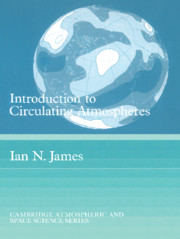Book contents
- Frontmatter
- Contents
- Preface
- Notation
- l The governing physical laws
- 2 Observing and modelling global circulations
- 3 The atmospheric heat engine
- 4 The zonal mean meridional circulation
- 5 Transient disturbances in the midlatitudes
- 6 Wave propagation and steady eddies
- 7 Three-dimensional aspects of the global circulation
- 8 Low frequency variability of the circulation
- 9 The stratosphere
- 10 Planetary atmospheres and other fluid systems
- Appendix: Solutions to Problems
- Bibliography
- References
- Index
10 - Planetary atmospheres and other fluid systems
Published online by Cambridge University Press: 14 January 2010
- Frontmatter
- Contents
- Preface
- Notation
- l The governing physical laws
- 2 Observing and modelling global circulations
- 3 The atmospheric heat engine
- 4 The zonal mean meridional circulation
- 5 Transient disturbances in the midlatitudes
- 6 Wave propagation and steady eddies
- 7 Three-dimensional aspects of the global circulation
- 8 Low frequency variability of the circulation
- 9 The stratosphere
- 10 Planetary atmospheres and other fluid systems
- Appendix: Solutions to Problems
- Bibliography
- References
- Index
Summary
Major influences on planetary circulations
Until recently, the study of global circulations has been confined to the circulation of a single system, namely that of the Earth. Throughout the earlier part of this book, we, too, have concentrated upon the Earth, showing how the poleward and upward transports of heat generate the kinetic energy associated with observed atmospheric circulations. We have described some of the forms which these heat fluxes can take, including the essentially axisymmetric circulations of the Hadley cells in low latitudes and the wavelike baroclinically unstable waves of the midlatitudes. These principles need not be restricted to the Earth's system alone. In this chapter, we will enquire how general are the particular heat transporting circulations observed in the Earth's atmosphere, and how they might be modified in different circumstances.
Such a discussion has become much more informed in the last 20 years or so, as the study of planetary atmospheres has advanced considerably. Spacecraft have now paid at least fleeting visits to every planet with a substantial atmosphere in the solar system, with the exception of Pluto, which may possess an atmosphere. In the case of Venus and Mars, direct in situ measurements of meteorological parameters have been made in addition to the more usual remotely sensed data. In the coming years, plans are under way for entry probes and direct measurements of other atmospheres, including those of Jupiter and Titan.
- Type
- Chapter
- Information
- Introduction to Circulating Atmospheres , pp. 342 - 385Publisher: Cambridge University PressPrint publication year: 1994



